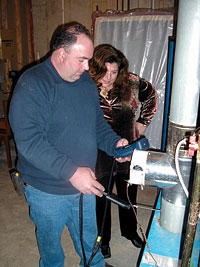
Weiss, Effikal's director of engineering, had attended a carbon monoxide (CO) panel discussion in late 2004 at the ISH North America convention in Boston. He remembered hearing one of the panelists, Jim Davis of the National Comfort Institute (NCI), speak on the problems of incomplete combustion and its direct impact on raised levels of indoor CO.
"I was aware that Liz was having issues with her boiler installation," he said. "I became the initiator, sharing the information I got from the panel discussion."
Hubbard was at her wits' end, trying to find a contractor who could correctly identify the source of the odor that reminded her of Sterno. And Hubbard was convinced that the odor signaled a greater problem - one that could affect the health of her family.
The four-year-old home was built with radiant floor heat and supplied by a 280,000-Btu, 78-percent AFUE boiler. There is a 2-ton air handler in the attic and 2-1/2- and 3-ton air handlers in the basement. From the beginning, Hubbard knew something was wrong.
"Within the first few months of the installation, the vent damper pipe had completely corroded," she said. "Being in the business for 20 years, I know why these things happen. The corrosion is caused by incomplete combustion.

She called the installing contractor and did not get the answers she was looking for. She also called the manufacturer, who recommended that she call the gas company. She did - and the gas company came out and told her she had no problem.
"I had other contractors and people recommended by the manufacturer come," Hubbard said. "They fired up the boiler and said that I didn't have a problem. But I knew I had a problem.
"I had to leave my air-to-air heat exchangers on 24/7, if for no other reason but to ensure that I had adequate ventilation in the house."
It was about this time that Weiss came back from the ISH meeting and recommended that Hubbard call Davis. She wanted to hook up one of the low-level CO monitors sold by NCI, but she knew there would be a catch.
"Jim won't sell his CO monitor unless I have one of his trained people come out to inspect the equipment," she laughed.
Davis recommended contractor Brian Garno of Garno Brothers Heating & Cooling in nearby Swartz Creek. Garno had attended Davis' class and was a certified NCI CO and combustion analyst.
Garno immediately noted that the boiler was not venting correctly. "I pulled the cleanout cap from the chimney, and the cold breeze hit my bald melon right away," he said. "I blocked the diverter, but that didn't fix the problem. The chimney looked good.
"I shut down the air handlers and discovered that the HRVs [heat recovery ventilators] were way out of balance, exhausting way more than they were bringing in. The chimney was backdrafting because the ductwork was supplying 1,600 cubic feet per minute (cfm) and only returning 800 cfm. There was a severe return air duct leakage."
Garno measured 2,000 parts per million (ppm) of CO coming out of the boiler, and he immediately shut it down.
"I was really upset because for four years I had been killing my kids," said Hubbard, who added that she was waking up every morning with her eyes almost swollen shut. "I thought I was allergic to something in my bedroom."
Garno saw some immediate fixes, including upsizing the ductwork and sealing the leaks. "I was not able to overcome the stack effect of the house and had to install a draft inducer," he said. "Based on Jim's suggestion, we decided to make it drop out once the chimney is warm and a good draft is established. If I can get the system balanced, we should have the problem solved."
"Very few contractors are trained to draw the connection between duct system performance and CO problems," Davis stated. "In addition, a regular CO detector would never have gone off. A low-level alarm, such as the NSI 3000 Monitor, will start beeping at 15 ppm.
"Every unqualified person will come in and blame the alarm. If we just give out low-level alarms to everyone, we haven't solved the problem - people will just keep blaming the alarms.
"We want our trained people to deliver the monitors to the customer so they'll know who to call."
Hubbard is straightforward in her assessment of the problem she faced - and the problems faced by other homeowners. "Here it is. I am in the industry, I talk to a lot of people, and it still took me four years to get the problem fixed," she said. "The whole issue is this: How can you fix a problem if you don't even acknowledge that one exists?"
And what if Weiss hadn't been curious about the ISH CO panel discussion? "If Corey hadn't attended the seminar, this problem might still be going on," said Davis.
For more information on NCI training and products, visit www.nationalcomfortinstitute.com.
Publication date: 02/21/2005

Report Abusive Comment